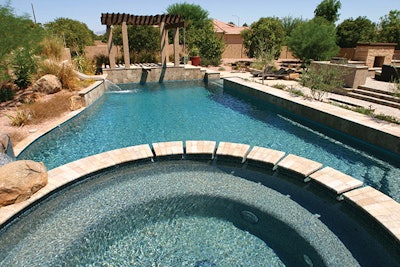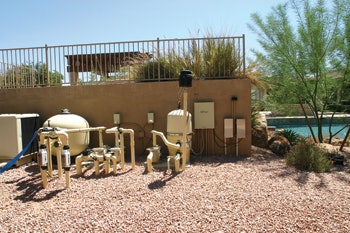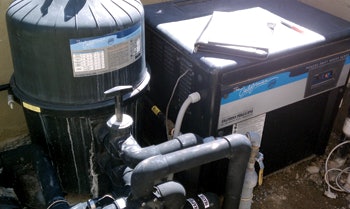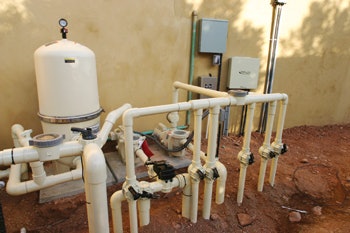
The pros and cons of the main types of pool filters — sand, diatomaceous earth (DE), cartridge — are generally well known in the pool industry. But which is the best filter for a particular job? Which is best for the environment? And is the most environmentally friendly filter necessarily best for every job?
At the fundamental level, sand filters are easiest to maintain because cleaning them requires only turning a backwash valve. Simple enough. Plus, the sand inside a sand filter holds up much longer than the media inside other types of filters. With DE, you get the clearest water because those fossilized exoskeletons of tiny diatoms filter out particles as small as 5 microns, effectively "polishing" the water. Meanwhile, the benefits of cartridge filters, particularly today's larger models, are relatively long filter cycles, more square footage of filtration area, and the fact that cleaning a cartridge filter consumes less water than the backwashing process typically required to clean sand and DE filters. And even large cartridge filters take up less real estate on the pad than a sand filter.
 The equipment pad for the pool shown on the opener.
The equipment pad for the pool shown on the opener.
Another point of comparison between filter types is the amount of resistance each adds to the system. This is particularly relevant for those interested in creating the most hydraulically efficient system. Sand filters add the most resistance to a pool plumbing system because moving water through the media bed requires high pressure. DE filters are next on the resistance comparison line, and cartridge filters add the least. In addition, sand and DE filters typically require backwash valves, which also add resistance because flow through typical backwash valves is inefficient. Because they don't require backwashing, cartridge filters often garner favor from those seeking the most-efficient filter.
The fundamental differences between the filter types seem to suggest that people who want to do the least work possible should opt for sand filters, people with the highest water-clarity standards should choose DE, and people who prioritize such environmental concerns as water conservation and reducing energy consumption should choose cartridge. But it's not that simple.
Some of the complications arise from recent product innovation that claims to have married the clarity of DE with the simplicity of cartridge. This is made possible by new DE grid designs that can be cleaned by rinsing with a hose — the same procedure as cleaning some cartridge filters.
 The DE filter and gas heater shown here were replaced by a cartridge filter and a heat pump as part of an overall efficiency-minded equipment upgrade. Among the problems addressed by the upgrade was the lack of a good outlet for the backwashed DE.
The DE filter and gas heater shown here were replaced by a cartridge filter and a heat pump as part of an overall efficiency-minded equipment upgrade. Among the problems addressed by the upgrade was the lack of a good outlet for the backwashed DE.
In many situations, the answer lies in determining the most significant need a new filter will have to meet — is it water clarity, physical size, ease of maintenance, conserving energy use and costs, or concern for the environment?
When presenting options to home-owners, for both new pools and renovation work, Rick Chafey, co-owner of Red Rock Pools and Spas in Gilbert, Ariz., almost always recommends large cartridge filters. However, on one recent job, he replaced a cartridge filter with a sand filter. Why? Because there was a massive amount of dirt getting into the pool.
The cartridges on this particular job required cleaning more than once a month because of frequent dust storms that the pool was not sheltered from, Chafey explains, adding that the cleaning frequency on this job was far greater than what even the most rugged cartridges are designed to withstand. Therefore, the cartridges were wearing out far sooner than the same cartridges would in a normal dirt-load situation. And the work to tear down the filters, clean the cartridges and reassemble the filters was excessive. When that task is required only once or twice per season, which is normal for large cartridge filters, it is quite manageable, but these cartridges were going from clean to dirty in about three weeks, Chafey recalls.
 A large cartridge filter plays its part on this equipment pad, designed for energy efficiency and overall performance. Other efficiency-motivated selections are the variable-speed pumps, large-diameter plumbing and a high-end automation system.
A large cartridge filter plays its part on this equipment pad, designed for energy efficiency and overall performance. Other efficiency-motivated selections are the variable-speed pumps, large-diameter plumbing and a high-end automation system.
So Red Rock replaced one of the two cartridge filters on this pool with a sand filter, which now handles the massive dirt load for the pool. The remaining cartridge filter is plumbed in for the laminars, which require cartridge filters, Chafey explains, because sand filters do not remove the smaller particles which could cause tiny blockages in the laminar nozzles and interfere with the smooth effect of these water features.
Another reason that Chafey typically specs cartridge filters is that they perform better at slower speeds than other types of filters, and Chafey uses variable-speed pumps whenever possible.
"When you run the pump longer and slower, you save energy," he explains. "Longer, slower filter cycles negate friction and head loss, so you get better filtration with slower flowing water."
To explain this phenomenon, Chafey describes trying to remove dirt from a T-shirt with both a fire hose and a sink faucet: A fire hose will push the dirt into and through the shirt, ruining it. However, holding a dirt-covered shirt under a sink faucet allows the dirt to rinse off the surface. Imagine the same comparison inside a filter. High pressure, high velocity water can force dirt into and through the media, rather than allowing it to be caught (i.e., filtered) by the media. Also, once it is embedded, it is very difficult to remove the dirt.
On a related note, the greater square footage of filtration area found in cartridge filters (compared with sand and DE) is one design feature that improves hydraulic efficiency. When you have 500 or more square feet of area on which to collect dirt (a typical size for large cartridge filters), there is a large area for water to move through, which translates to needing less energy to move that water.
This also means that resistance to flow increases at a slower rate as dirt collects inside a large cartridge filter because it takes longer for dirt to accumulate on a measurable percentage of the media.
The greater efficiency of cartridge filtration was central to another Chafey recommendation. Red Rock Pools was asked to bid on an overall efficiency upgrade, a bid which included two new cartridge filters in place of two aging DE filters. "They didn't realize there was an option other than DE," Chafey recalls, adding that this pool's features did not require the extraordinary water clarity associated with DE.
"If you have a customer who wants to view the pool at night through an acrylic window, then the water clarity you get with DE will be noticeable, but you won't see the difference during the day in a normal pool," according to Chafey.
Another reason for swapping in cartridge for DE on this job is that the filter elements had reached the end of their useful life. The DE filters could have been repaired and serviced, but Chafey saw that the cost of getting the DE filters back to working condition (taking them apart, replacing the elements, etc.) was closing in on the cost of new cartridge filters. The homeowner agreed to include new filters in what turned into a $20,000 equipment upgrade. (The job also included a heat pump in for a gas heater, variable-speed pumps in for older technology and a new automation system.) A photo of the equipment pad prior to the upgrade is on page 30. This project also presented a challenge in that there was no good place on the property for disposal of the DE while backwashing. The property is on the side of a mountain in Phoenix. It has no lawn to speak of (which is where used DE is sometimes distributed), nor was backwashing into the sewer practical because of the distance and elevation between the filter and the nearest sewer. (Many municipalities have rules against this practice.)
In both cases, Red Rock's customers ended up with more-efficient, easier-to-care-for equipment pads and the right filters for the jobs.
Comments or thoughts on this article? Please e-mail [email protected].







































